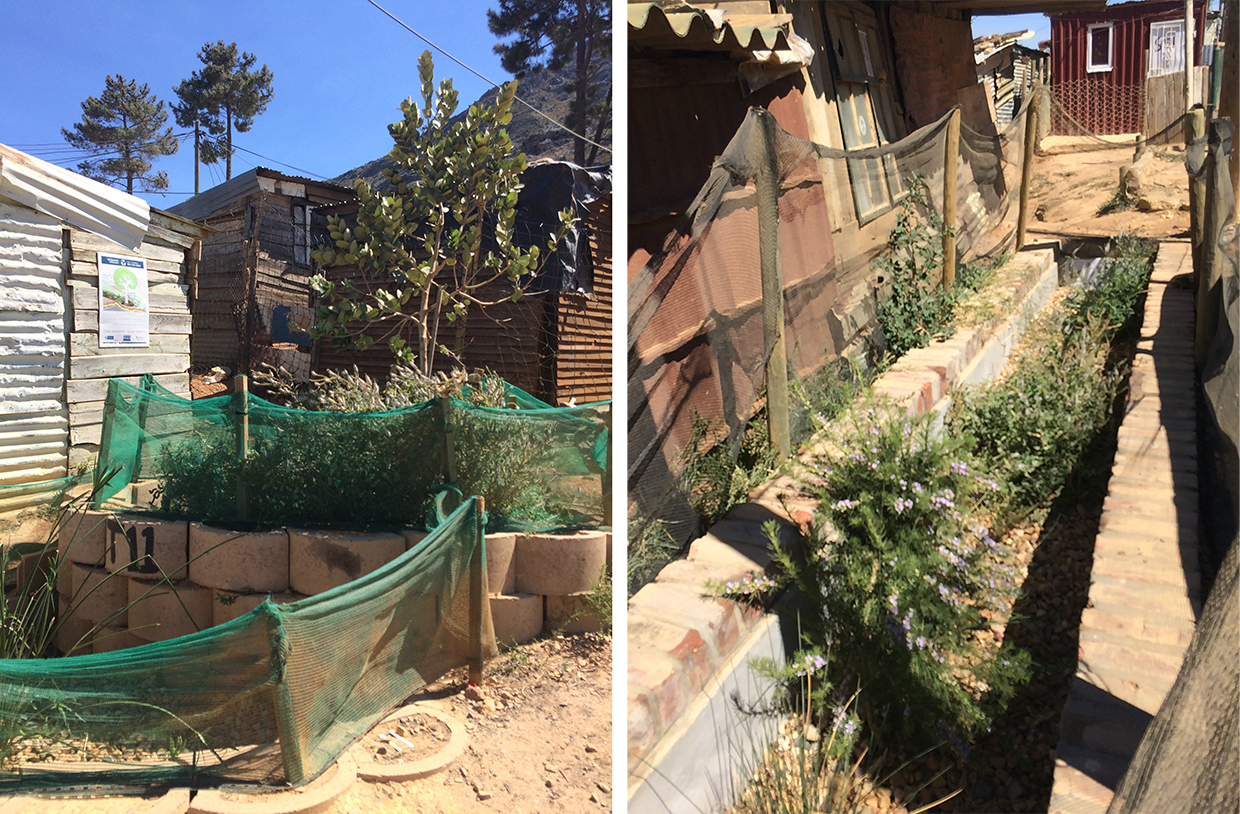Editors’ note: Researchers at SRC explore many ways to implement resilience thinking with multiple partners and approaches. Rethink invited this commentary from the Massive Small Collective, an international network of urbanists, development practitioners, and researchers who support small-scale and incremental solutions to the challenges of sustainable urban development. Massive Small looks at examples of projects around the world that work with the complexity of urban environments.
The informal settlement of Langrug in the Western Cape of South Africa is mostly devoid of greenery. Its dirt roads are uneven and muddy, with stagnant water overflowing from open gullies. Water and sanitation facilities are hard to access. But in one area something unusual has been happening.
Small gardens of trees, patches of human-made wetlands, and a network of submerged pipes now make up a “green infrastructure” that cleans the neighbourhood’s grey water (water that was used for washing and household chores), with so-called biomimicry – design inspired by nature. And this system solves water treatment issues while beautifying the landscape and eventually providing small-scale economic opportunities to the residents of Langrug, who have helped design, and now co-manage, the system.
This project, called the Genius of Space (Systems for People’s Access to a Clean Environment), is not just an emergency intervention providing substandard infrastructure as a stopgap measure “for the poor”. The project’s multidisciplinary team wants to demonstrate a better and greener way for government to deliver infrastructure and build resilience in communities. The goal is for this method to become a model that can be used in different
settings around the world.
We at Massive Small are investigating models and initiatives like the Genius of Space in order to understand how they are able to succeed in building resilience in complex environments, where others have failed, and what lessons can be learned and applied elsewhere.
An approach inspired by nature
In many ways, Langrug is emblematic of the profound inequality that still characterises South Africa’s urban spaces, two decades after apartheid’s end. Informal settlements are one legacy of apartheid planning, which was defined by racist and classist policies that created segregated communities with starkly different developmental trajectories.
Like many informal settlements, Langrug’s dwellings lack basic supportive infrastructure and access to services. Healthcare, waste management, sanitation, and other services are almost entirely missing, and residents have few economic opportunities.
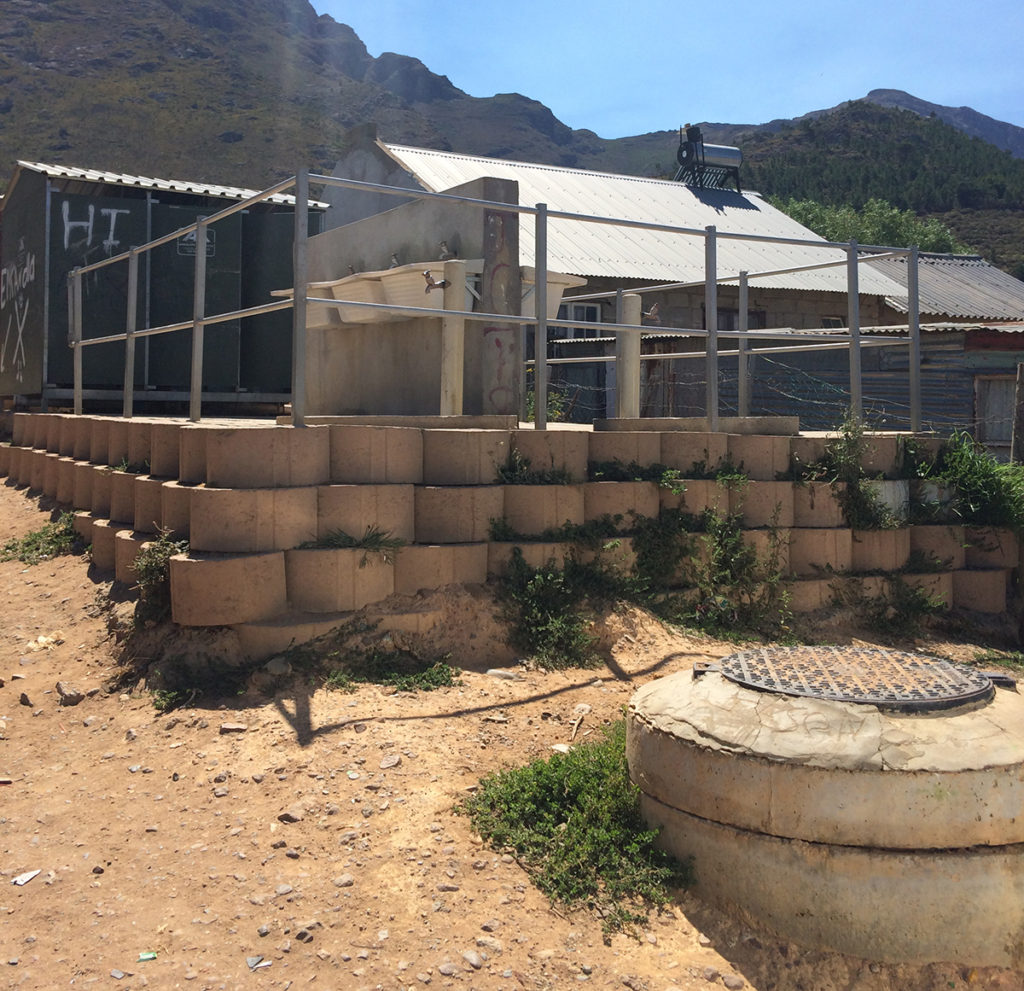
A public ablution block, installed and owned by the municipality. Copyright: Lauren Hermanus.
Local and federal government agencies struggle to work effectively in informal settlements like Langrug.
See all references
Over time, their failure to deliver on the promise of improved livelihoods has led to a breakdown of trust and confidence on both sides.
For years, the only solution for grey-water and waste-water management in Langrug was a system of pipes and open gullies running through the settlement. It was a solution that the community implemented with limited means. The water stagnates in these channels for most of the year, harbouring bacteria that create a health hazard, and emitting terrible odours. When winter rains come, the contaminated water washes into the Berg River, where it further damages the local river’s ecosystem, already stressed by agricultural runoff.
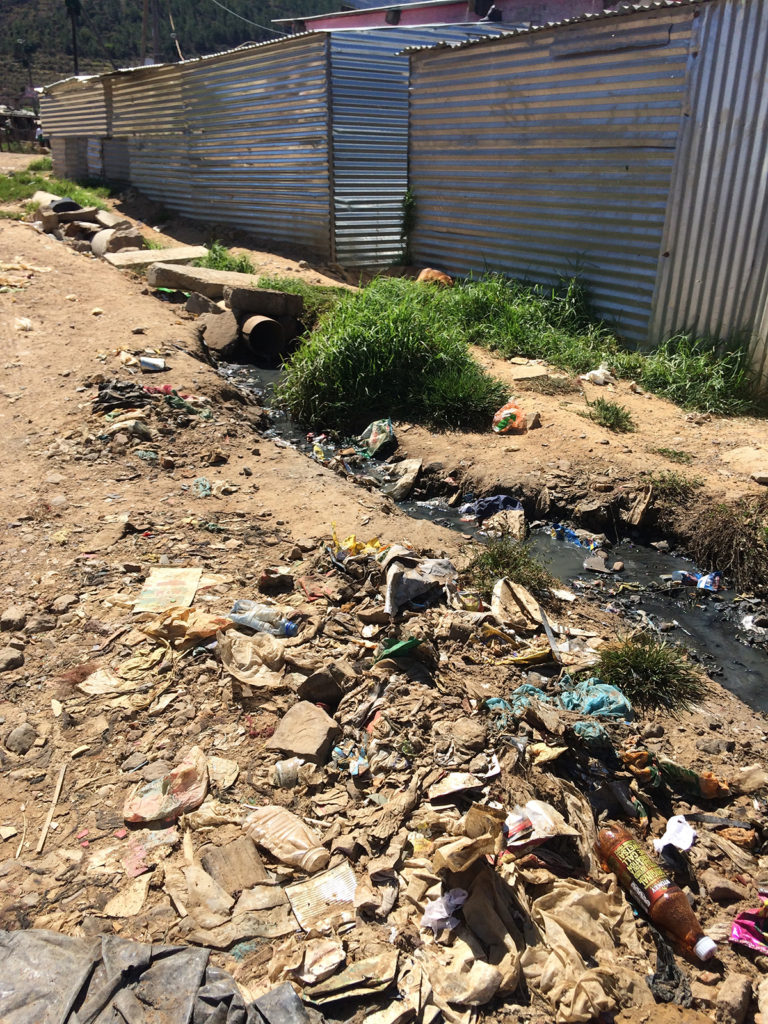
Open gullies that channel grey-water overflow, muddying the dirt road. Copyright: Lauren Hermanus.
In early 2014, an interdepartmental task force from the Western Cape Government launched the Genius of Space, led by Jason Mingo of the Department of Environmental Affairs and Development Planning. The project’s team understood that the challenge of water management in and around human settlements cut across the policy mandates of different government departments.
As part of the regional government’s commitment to sustainable infrastructure, officials from the region’s Department of Environmental Affairs and Development Planning wanted to test green and resource-efficient infrastructure that could be used in formal and informal neighbourhoods. The Department of Human Settlements was looking to deliver affordable infrastructure and services within the dense informal settlements. And the Department of Economic Development and Tourism saw the project as a way to prototype a new green technology that could be locally produced, also potentially creating microenterprises for residents. The interdepartmental collaboration offered a more efficient way of working across goals and budgets, which are usually divided into silos.
The government taskforce had seen the outcomes of using the “usual methods” here and in other neighbourhoods, i.e. delivering a technical solution for Langrug with little or no input from its residents. For example, the municipal government had built central “ablution blocks” housing toilets and cement washbasins in brick buildings. Half no longer function and, for most of Langrug’s inhabitants, these facilities are too far to walk at night. The solution was not one that worked for them.
Government priorities and choices do not always line up with what people need and want, and engagement processes are often perceived as far too shallow, particularly by residents themselves. As Trevor Masiy, a community leader who represents its interests in the project, says, “We in Langrug have seen top-down fail, so we are trying from the bottom, up. We need to have real processes to find out what the community really wants and needs. We want to meet government halfway.”
The Genius of Space was the culmination of almost three years of government work with biomimicrySA, a regional network of The Biomimicry Institute, to unlock the potential for bioremediation solutions – cleaning up soil or water using microbes or plants, for example. The project introduced the new thinking necessary to tackle the interconnected challenges facing Langrug. Appointed to lead the project, biomimicrySA gathered more members with varied and critical technical skills and experience that would complement the team’s existing knowledge: engineering, community engagement, water management and more.
The team began the project expecting to put in place a conventional grey-water treatment solution. But by taking sufficient time and incorporating diverse perspectives, they would instead end up creating a system of green infrastructure that runs through the neighbourhood.
Using natural processes as their blueprints, the Genius of Space team created a hybrid system that integrated ecosystem services, such as water filtering, and trapping and breaking down biological waste, into their engineering designs to provide services in the settlement. The result is a network of traditional pipes and channels integrated with small wetlands, each about the size of a bathtub, containing water plants that pull out organic waste and other pollutants. Connected to the wetlands, small tree gardens also filter the water. Together, these “living” gutters remove excess nutrients and pollutants.
One advantage of using nature-based solutions, environmental engineers say, is that the living organisms in the engineered systems regenerate themselves, requiring less maintenance and fossil-fuel energy than pipes and filters in traditional engineered systems. These bio-inspired systems also provide habitats for many different species, while growing green spaces for human inhabitants to enjoy.
See all references
Making infrastructure that works for people
The waste water treatment system was only the first step in a programme that would tackle water, sanitation, and solid waste. These initial interventions were meant to be catalysts for future development, rather than short-term outputs on a project plan. The team wanted to figure out: What value could the new infrastructure add, beyond waste and water management?
This year, the project enters a new phase. The project team and residents of Langrug are starting to design and figure out costs for possible enterprises that could be sustained by waste captured in the Genius of Space system. These businesses might “upcycle” organic and inorganic waste, for example, by composting to create clean soil. The upcycled product could then be used in small-scale farming for flowers.
Genius of Space saw community engagement as a valuable resource and critical to the successful design of the system.
Community engagement can be approached as a fraught, costly process aiming to win people over to a technical solution or some expert-designed “good” or “best” practice that may not fit people’s everyday lives and needs. Instead of seeing individuals and their preferences as a hurdle, where a community must be persuaded by outsiders to accept a solution, project leaders in the Genius of Space saw community engagement as a valuable resource and critical to the successful design of the system. Mingo and his colleagues knew that residents would understand the local context and their own needs, risks, and opportunities at a scale that is not visible from a government office.
“As the project continued, it became more and more clear that the deep work that this project was centred around was less about the physical infrastructure, and more about the growing relationship between the government and the residents, [increasing] agency and the long-term impacts that this generated,” he says.
A slow, considered approach has leveraged the creativity of Langrug’s residents in a way that top-down interventions usually fail to do. Government actors and service providers did not insist on imposing predetermined outcomes, Mingo says. Their emphasis was on providing new tools to grow the capacity of residents to respond differently to the challenges they experience.
Start slowly, build up the pace
“Resilience is about having the capacity to deal with change, be it a sudden and unexpected disaster such as a drought, or ongoing inexorable change such as urbanisation,” says Reinette “Oonsie” Biggs, professor of social-ecological systems and resilience at Stellenbosch University and researcher at the Stockholm Resilience Centre, who is working with us at the Massive Small Collective. Without the most basic infrastructure and services, residents of informal settlements are vulnerable to social, political, economic, and ecological turbulence. Shocks could be as varied as extreme weather, disease outbreaks, or forced relocations.
Biggs says that building resilience in a dynamic, social-ecological system requires working in a multifaceted, adaptable way. Rather than delivering predefined solutions, such work requires a certain kind of slowness and time to develop contextual awareness.
The Genius of Space team followed this kind of pattern. Instead of designing and delivering an external solution, they cultivated interdisciplinary thinking and worked in partnership with and with accountability to Langrug residents. And of course, they worked with a long-term view in their thinking and planning: the first phases began in 2012, with discovery, scoping, and design; actual building began in January 2016. Not until the system is evaluated will the team decide if it’s good enough to spread into the entire Langrug settlement.
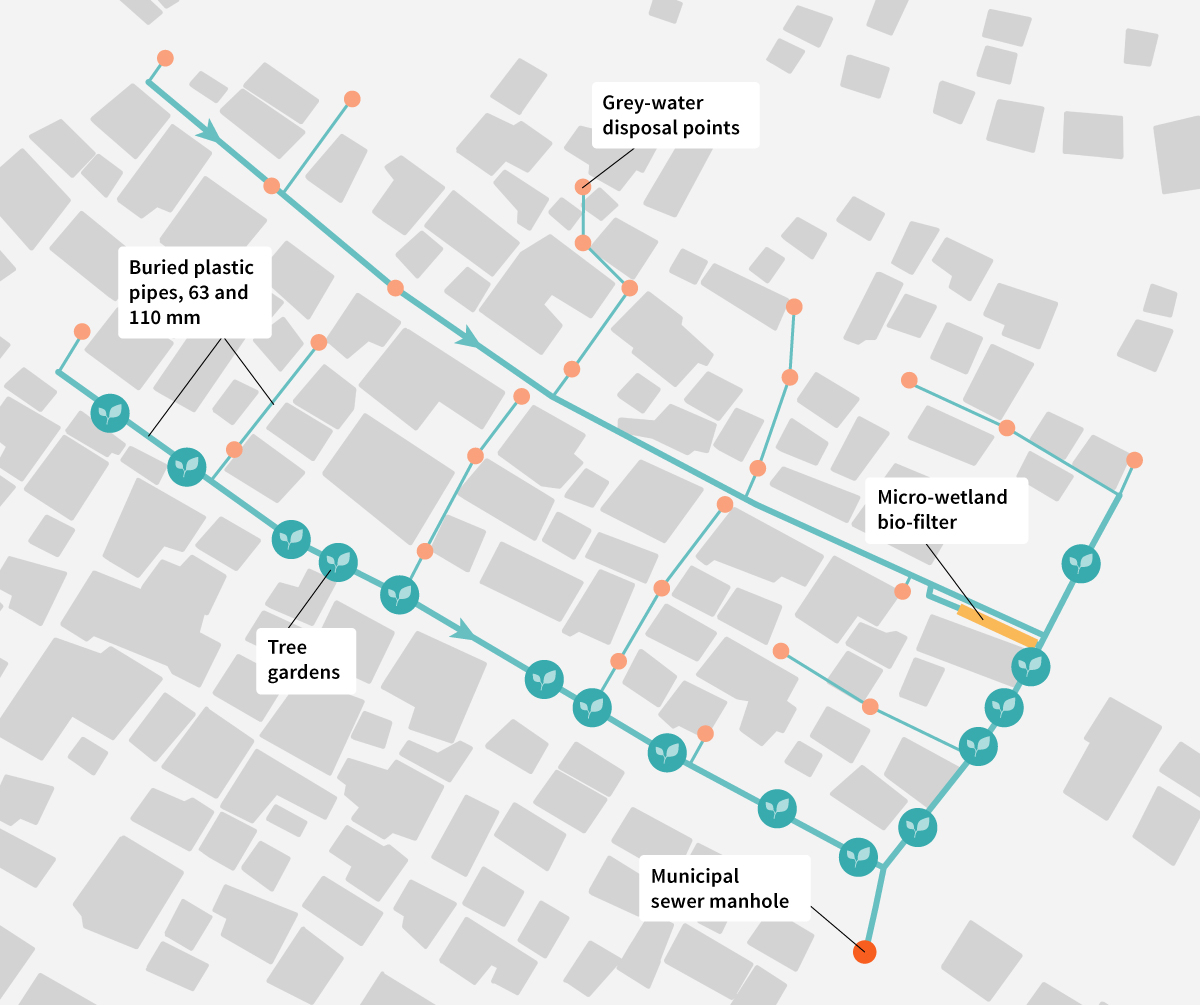
Conceptual drawing of the network of buried plastic pipes linking grey-water inputs to tree gardens in Langrug, with the microwetland for further treatment. The informal settlement also has water mains to deliver water to some houses and a separate sewage line, not shown here. Illustration: Elsa Wikander/Azote.
Langrug is not the only place where this method could be put to work. Informal settlements across the world are set to triple in the next few decades.
See all references
These places and their residents lack the necessary conditions to evolve into what we call “successful urbanism”, where people can have a good quality of life as they themselves define it. Instead, they can become locked into a state of arrested development that is highly precarious.
The pace and scale of urbanisation can place an immense strain both on local ecosystems and on public infrastructure and service delivery.
See all references
As the promise of economic opportunity continues to draw people towards cities and towns, these issues have become a global concern. In this context, the slow-moving systems that govern the public sector, its budgets, and accountability can be ill-suited to building resilience in rapidly growing settlements, with disordered layouts and their own social and political characteristics.
Governments have limited resources, multiple mandates, and many constituencies with varying needs and levels of influence and agency. As people have migrated to centres of economic activity, informal dwellings or whole settlements like Langrug have emerged as a bottom-up response to the lack of housing and other infrastructure in these areas. Governments struggle to respond, from favelas in Rio de Janeiro to the slums of Delhi. Often, they treat neighbourhoods like these as illegitimate or respond with “erase and replace” thinking.
See all references
Over time, residents of underserved and unplanned settlements acquire nuanced understandings of their environment and problems, and they develop solutions in spite of having extremely limited resources. But governments might fail to see the creativity and validity in these solutions, or the importance of how residents are finding solutions.
See all references
The Genius of Space project is an attempt to demonstrate a way of working with rather than against informality. It provides technical expertise that catalyses the creative energy of the residents, to co-design context-appropriate, useful infrastructure.
Massive potential of a small start
The Genius of Space has demonstrated how cooperation on different mandates and across disciplines – in this case interdisciplinary and interdepartmental collaboration – can mean that a single project is able to achieve several developmental outcomes with fewer resources. By working with residents to develop a deeper understanding of people’s needs, the project team hopes that the capital invested now will continue to have greater impact and relevance into the future. This relationship holds the potential to “unarrest” Langrug’s development, setting new parameters for the settlement to evolve into successful, sustainable urbanism.
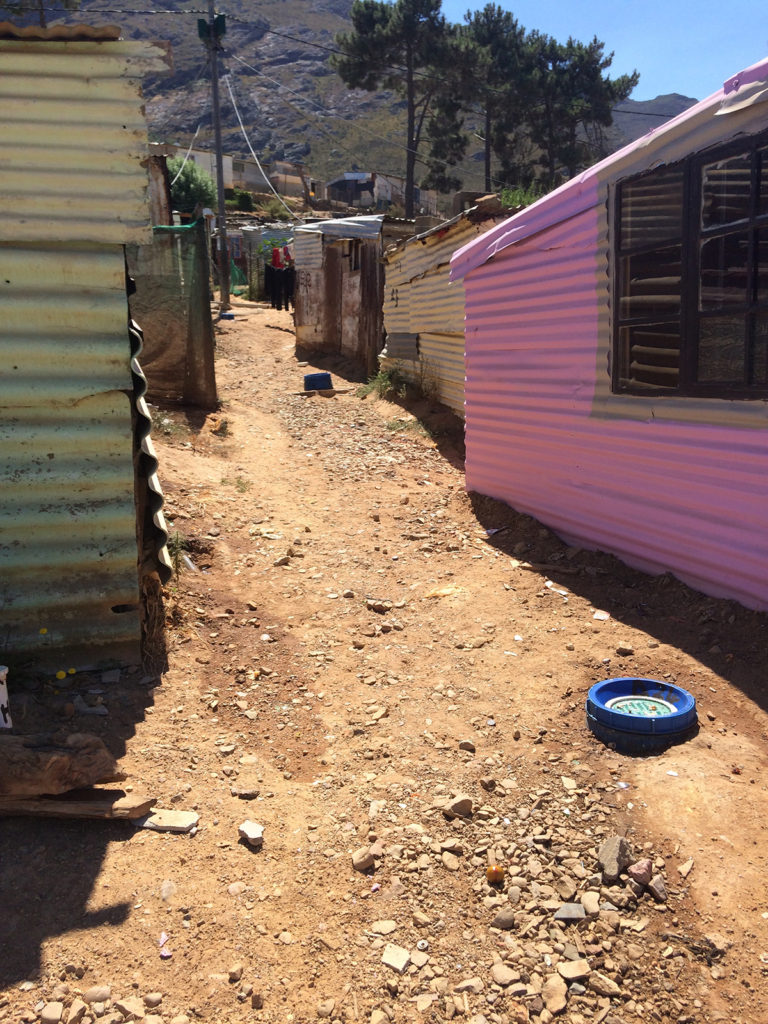
A section of Langrug with new grey-water disposal points to keep the road clean and dry shows the dramatic difference in efficacy compared with the old system. Copyright: Lauren Hermanus.
It is still early in the life of this project, which will be tested again and again as it expands and is replicated. We believe there is cause for cautious optimism, however. By beginning small and working incrementally, the Genius of Space has organically incorporated fundamental aspects of building resilience.
The project has also worked in what we would define as a distinctly Massive Small way. This refers to many small improvements and transactions, primarily performed by people and not larger organisations, that lead to a cumulative, collective, fundamental improvement of the urban system. These iterations of failure and success allow people to learn from mistakes and evolve practices to better respond to a dynamic environment. This is a critical part of resilience thinking.
The Genius of Space is just one example of an emergent approach we are seeing in many projects across the world. Massive Small plans to continue telling stories like this one to show how top-down and bottom-up strategies for urban development can work together to build resilience.


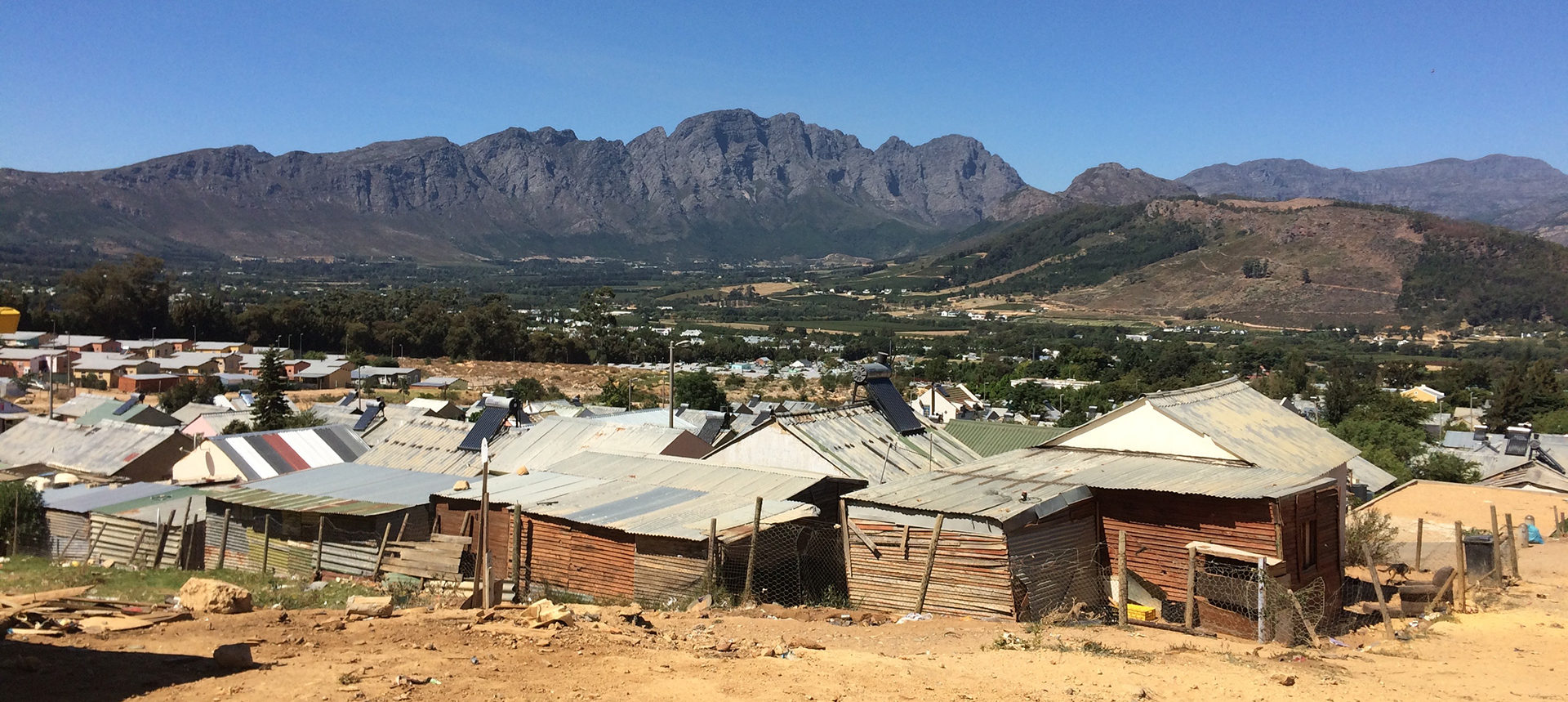
 15 MIN READ / 2278 WORDS
15 MIN READ / 2278 WORDS

